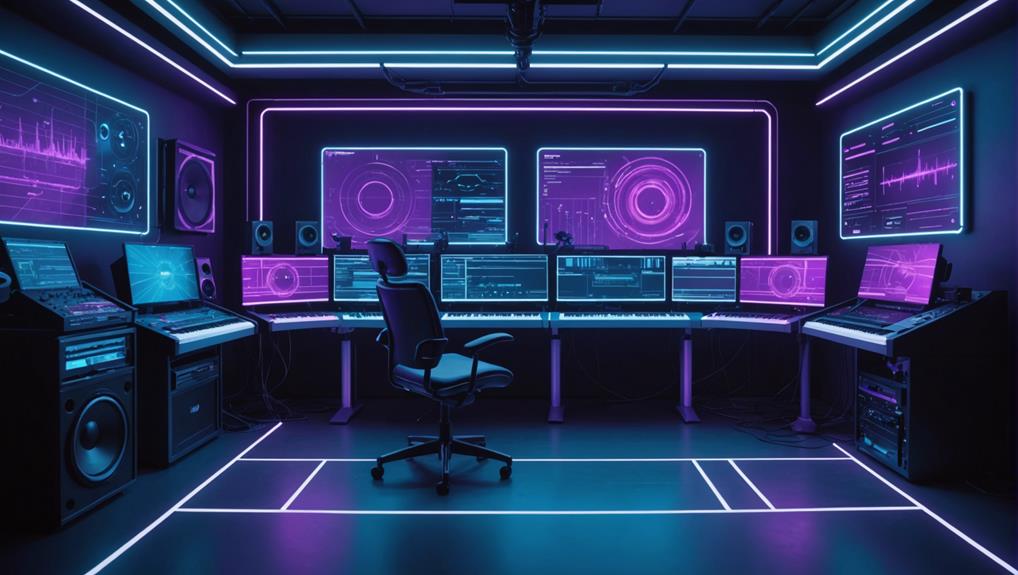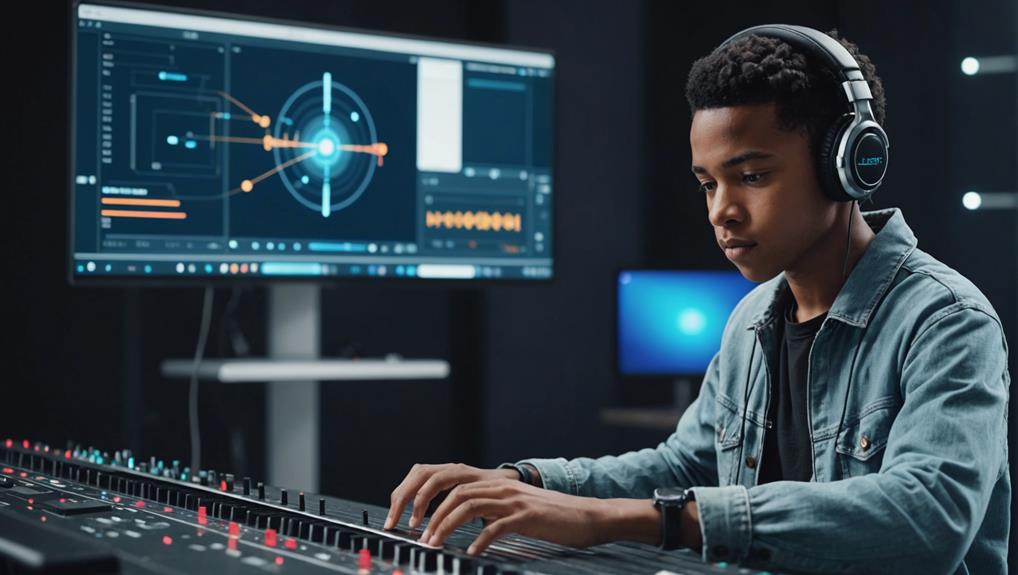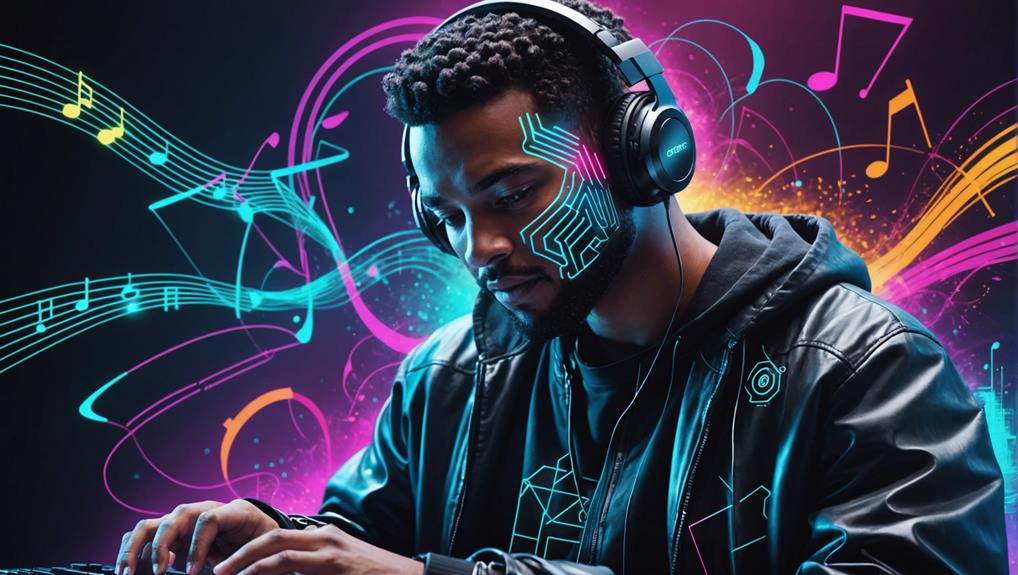No products in the cart.
AI is reshaping your creative process in electronic music composition by utilizing advanced algorithms to analyze vast datasets and generate innovative soundscapes. These tools offer you real-time collaboration capabilities, enabling you to experiment with novel harmonic structures and complex rhythmic patterns. With AI, you’re not just creating music; you’re crafting groundbreaking sounds that push the boundaries of traditional genres. Platforms like Google’s Magenta and OpenAI’s Jukebox embody this fusion of algorithmic precision and artistic intuition, amplifying your ability to explore new musical territories. As AI continues to evolve, the potential for even more nuanced compositions unfolds.
Key Takeaways
- AI-driven tools like Google’s Magenta generate innovative melodies and harmonies, enhancing creative musical processes.
- Machine learning algorithms enable unique rhythmic and harmonic structures, pushing the boundaries of conventional music composition.
- Collaborative AI platforms such as Soundtrap and BandLab facilitate real-time music composition and experimentation among artists.
- AI influences electronic music by introducing genre-defying elements and novel sonic textures, redefining traditional genre boundaries.
- AI enhances artist creativity by providing new tools and methods for exploring unique musical expressions and dynamic compositions.
Exploring AI-Driven Soundscapes
AI-driven soundscapes are transforming electronic music composition by utilizing machine learning algorithms to forge unprecedented and intricate sound textures. As you explore the domain of electronic music, you’ll find that these AI systems, by analyzing vast arrays of musical data, aren’t just tools but collaborators. They generate AI-generated melodies that push the envelope of what’s traditionally expected in musical composition.
Imagine a scenario where your creative process is augmented by AI. Tools like Google’s Magenta aren’t merely producing random notes but are capable of learning and adapting from an extensive dataset of genres, styles, and historical music epochs. This capability allows you to venture into experimental collaborations that were once deemed implausible. You’re no longer just a musician but a pioneer in a sonic exploration where technology meets creativity.
The intersection of AI with music isn’t about replacing the artist but enhancing your artistic voice. Through these collaborations, you’re able to create soundscapes that are rich, layered, and emotionally resonant in ways that were previously unreachable. This isn’t just evolution; it’s a revolution in how music is conceived and perceived, setting a new standard for what’s possible in electronic music composition.
AI and Novel Harmonic Structures
Harnessing machine learning, AI analyzes and creates groundbreaking harmonic structures in electronic music, pushing traditional boundaries and inspiring innovative compositions. By delving into vast musical data sets, AI identifies and exploits unconventional harmonic relationships and tonalities, ushering in a new era of harmonic innovation. This not only challenges established music theory norms but also opens avenues for creative exploration previously constrained by human cognitive limits.
The integration of AI in electronic music composition has led to the generation of unique chord progressions and harmonies. These elements, crafted by AI algorithms, aren’t bound by traditional scales or modal frameworks, thereby enriching the auditory palette available to composers. The result is a fresher, more diverse range of sonic experiences that can captivate and engage audiences in novel ways.
Here’s how AI’s novel harmonic structures can enhance your music:
- Diverse Tonalities: Explore beyond conventional scales for richer, more complex compositions.
- Unique Chord Progressions: Employ AI-generated sequences that offer unexpected auditory delight.
- Enhanced Creativity: Break free from traditional constraints and experiment with innovative soundscapes.
- Creative Inspiration: Draw upon AI-suggested harmonics to spark new musical ideas.
- Advanced Composition Tools: Leverage AI capabilities to refine and evolve your musical style.
Embrace these tools to push the envelope of what’s possible in electronic music.
Machine Learning in Rhythm Creation
Machine learning algorithms revolutionize rhythm creation in electronic music by analyzing and generating dynamic new patterns that reflect a range of global styles. Neural networks dig into vast databases, learning from thousands of rhythmic sequences across genres from hip-hop to techno. This capability not only mimics but often surpasses traditional rhythmic patterns, offering you unprecedented creative avenues.
Let’s consider AI learning curves and how they impact your music. Initially, the technology may replicate familiar patterns, but as it learns, it starts proposing rhythmic innovations that can transform mundane tracks into intriguing sonic adventures. Tools like Rhythmiq allow real-time manipulation, giving you the power to tweak AI-generated rhythms on the fly, ensuring they fit perfectly with your musical vision.
Here’s a quick look at how AI influences rhythm creation:
| Feature | Benefit |
|---|---|
| Diverse Style Mimicry | Adapts to any genre from jazz to techno |
| Real-time Manipulation | Tweaks rhythms during live performances |
| Innovative Learning | Constantly evolves with AI learning curves |
| Streamlined Creation | Reduces time spent on manual programming |
Through these advancements, machine learning doesn’t just support your creative process—it propels it, allowing you to explore and implement complex rhythmic structures with ease.
Collaborative Tools for Musicians
As you delve into the world of electronic music composition, consider how real-time editing platforms transform your interaction with musical elements.
These platforms allow you to manipulate and modify music collaboratively, ensuring that your creative output is both dynamic and innovative.
Shared creative interfaces further empower you and your peers to seamlessly integrate diverse ideas and techniques, enhancing the collective creative process.
Real-Time Editing Platforms
Real-time editing platforms like Soundtrap and BandLab empower you to collaboratively compose and modify music instantaneously, regardless of physical location. These tools facilitate an innovative blend of AI-driven inspiration and collaborative experimentation, transforming how you engage with music production. They not only break geographical barriers but also enhance the creative process through instant feedback and diverse musical inputs.
- Instant Collaboration: Work with musicians globally without delay.
- AI Integration: Utilize AI tools for enhanced musical creativity.
- Feedback in Real-Time: Immediate reactions and adjustments.
- Cross-Platform Accessibility: Access your projects on any device.
- Comprehensive Toolset: Embrace a wide array of built-in loops, instruments, and recording options.
These features collectively expand your creative horizons, pushing the boundaries of traditional music composition.
Exploring shared creative interfaces allows musicians to immerse themselves in a real-time, collaborative environment, seamlessly blending their talents. These platforms enable you to engage in virtual jam sessions and remote music production, overcoming geographical limitations.
By utilizing AI-assisted collaboration, you’re not just delving into sharing files; you’re interacting dynamically with fellow artists, contributing to and modifying the musical piece instantaneously. This interactive music creation process leverages real-time feedback, ensuring that every nuance and creative impulse is captured and integrated effectively.
These tools don’t just facilitate, they enhance the creative synergy among participants, making the fusion of ideas fluid and continuous. As you engage in these shared spaces, the boundaries of personal studio and global stage blur, revolutionizing how music is composed collectively.
AI Impact on Electronic Genres
As you explore the evolving landscape of electronic music, you’ll find that AI’s role is pivotal in reshaping genres like techno and EDM. AI’s capability to assist in genre evolution empowers you to craft new sounds and structures by integrating creative tools that analyze and reinterpret vast datasets of music patterns.
This technological infusion not only enhances your creative process but also pushes the boundaries of what’s possible in electronic music composition.
Genre Evolution Assistance
AI tools actively reshape the landscape of electronic music by enabling the creation and evolution of new genres. You’re seeing this as AI-inspired melodies and unconventional structures become commonplace. With AI assistance, the boundaries of what defines a genre aren’t just pushed but often completely redefined, leading to genre-defying experimentation.
- Data Analysis: AI analyzes vast amounts of music data, identifying emerging trends.
- Sound Exploration: Producers experiment with AI-generated sounds, pushing traditional genre boundaries.
- Innovation Freedom: AI algorithms empower artists to break free from genre constraints.
- Trend Identification: AI pinpoints trending sounds and styles in real-time.
- Subgenre Creation: The fusion of technology and creativity leads to diverse new subgenres.
Creative Tool Integration
Building on the genre evolution, the integration of AI tools like Google’s Magenta enhances your creative process by generating innovative melodies and harmonies that transform electronic music composition. This AI collaboration isn’t just about automation; it’s a fusion of your artistic intuition with advanced algorithmic improvisation.
Tools like AIVA and OpenAI’s Jukebox act as catalysts in your studio, offering real-time inspiration and a vast array of complex rhythms and textures at your fingertips. You’re now able to push the boundaries of techno, house, and ambient genres, crafting soundscapes that were once unimaginable.
The seamless blend of AI-generated elements with human creativity marks a new era in music production, shaping the future landscape of electronic music.
Enhancing Creativity With Algorithms
Harnessing algorithms greatly enhances creative possibilities in electronic music composition by introducing novel tools and techniques. When you explore AI-driven inspiration and creative exploration, you’re delving into a reservoir of endless musical possibilities. Algorithms don’t just replicate traditional methods; instead, they push boundaries and redefine what’s possible in music creation. Through algorithmic composition, you can access levels of artistic innovation that were unimaginable before.
Imagine an algorithm that not only learns from existing musical data but also suggests new chord progressions or sound combinations that you mightn’t have considered. This collaboration between human creativity and artificial intelligence leads to a synergetic relationship where both parties contribute to the creative process, propelling the music to new heights.
- Pattern Analysis: Algorithms dissect complex musical structures to inspire fresh ideas.
- Complex Rhythms: AI generates intricate beats that challenge conventional rhythm patterns.
- Novel Melodies: Delve into uncharted melodic territories with AI suggestions.
- Texture Exploration: Experiment with rich, multi-layered textures that AI helps you design.
- Dynamic Compositions: Shift and evolve music dynamically over time with AI input.
This isn’t just about making music; it’s about pioneering new forms of artistic expression.
AI Song Contests and Innovation
You’ve observed how AI song contests like DeepMusic’s annual event not only showcase novel AI composition techniques but also challenge and expand your understanding of creativity in music.
These contests are pivotal in demonstrating how AI influences artist creativity, pushing composers to explore new domains of musical expression.
Looking ahead, the evolution of these contests could dictate major shifts in the future landscape of AI music, shaping how technology and creativity continue to intertwine.
Novel AI Composition Techniques
Exploring novel AI composition techniques, annual AI song contests such as those hosted by DeepMusic are revolutionizing the landscape of electronic music creation. These contests highlight AI-driven melodies and futuristic approaches, showcasing how algorithmic arrangements can lead to innovative, experimental techniques. By pushing the boundaries of what machines can create, these events challenge and expand the traditional views of artistic creation in music.
Here are key insights into how AI is reshaping music composition:
- *AI-driven melodies* harness complex algorithms for fresh, unexpected musical sequences.
- *Algorithmic arrangements* facilitate new structures and patterns not typically conceived by humans.
- *Experimental techniques* emerge from AI’s ability to learn and iterate rapidly.
- *Futuristic approaches* in music are becoming standard as AI integrates deeper into the creative process.
- *Innovative compositions* are celebrated, encouraging continual advancement and exploration.
Impact on Artist Creativity
As AI song contests like those organized by DeepMusic become more prevalent, they greatly amplify artist creativity by offering novel tools and methods for musical expression. These contests aren’t merely competitions; they’re incubators for creativity enhancement, promoting an unprecedented level of AI collaboration.
You, as an artist, are thrust into a domain where your traditional methods blend with cutting-edge AI technologies, pushing the boundaries of what’s possible in electronic music. This fusion empowers you to explore and manifest unique musical expressions, which were once beyond reach.
Through such innovative platforms, your artistic potential expands, leveraging AI to not only augment your existing skills but also to inspire new forms of artistic expression in the electronic music landscape.
Future of AI Music
Building on this momentum, the future of AI music, particularly through AI song contests, promises even more radical innovations and collaborations. As AI-driven inspiration becomes integral, you’ll see a surge in creative workflow optimization. This fusion not only enhances experimental music creation but also pioneers innovative composition techniques.
Here’s what to watch for:
- Experimental Platforms: AI explores new sonic territories, pushing the envelope of musical genres.
- Collaborative Processes: Unprecedented partnerships between AI and renowned composers.
- Dynamic Tools: Advanced software fostering quicker, more creative music production.
- Diverse Expressions: Broader spectrum of artistic outputs reflecting varied global cultures.
- Competitive Innovation: AI song contests driving the boundaries of what music can achieve, setting new standards in the industry.
Ethical Considerations in AI Music
AI-driven music creation introduces significant ethical challenges, particularly concerning copyright ownership and the authenticity of compositions. You’re entering a domain where ethical ownership intersects with creativity. How does one guarantee that AI-generated music respects the rights of original composers? Additionally, the authenticity of these compositions is under scrutiny. With AI tools capable of mimicking styles and voices, distinguishing original works from AI-generated ones becomes intricate.
Authenticity and diversity also take center stage. The technology’s ability to clone voices and mimic styles using deepfake technology poses unique challenges. You must consider whether these technological advancements enhance the diversity of music or merely replicate existing biases.
Here’s a breakdown of the key ethical issues:
| Aspect | Concern | Impact on Music Industry |
|---|---|---|
| Copyright | Ownership of AI compositions | Legal disputes, royalties |
| Authenticity | Deepfake and voice cloning | Erosion of originality |
| Diversity | Bias in AI algorithms | Reduced cultural variety |
Balancing democratization and quality is essential. As AI democratizes music production, ensuring that this doesn’t compromise quality is a critical challenge. You’re tasked with exploring these waters, ensuring that innovation doesn’t overshadow ethical considerations and cultural significance.
Real-World Applications and Case Studies
Exploring real-world applications, artists like Holly Herndon and platforms such as WaveAI’s LyricStudio demonstrate how AI is reshaping music composition and production. You’ll find that Herndon’s use of AI for creating unique vocal and harmonic elements not only enhances her music but also pushes the boundaries of traditional soundscapes. Similarly, WaveAI’s LyricStudio has been instrumental for artists like Curtiss King, who achieved a number one spot on the iTunes Hip Hop charts through AI-assisted lyric generation.
These examples highlight a larger trend of AI-driven experimentation and innovative collaborations within the music industry. Dr. Maya Ackerman’s AI tools exemplify this shift, focusing on augmenting human creativity without entangling artists in issues of royalties or ownership. This approach guarantees that the core of artistic creation remains with the creator, while the technology serves as a facilitator.
Here’s how you can appreciate the depth and breadth of AI’s impact on music:
- Holly Herndon’s integration of AI in vocal processing
- LyricStudio’s role in matching lyrics to artist styles
- Curtiss King’s chart-topping success with AI-generated lyrics
- Dr. Maya Ackerman’s AI tools emphasizing human creativity enhancement
- MelodyStudio’s influence on altering songwriting approaches
Future Trends in AI Music Composition
Increasingly, AI tools like AIVA and Flow Machines are setting the stage for collaborative advancements in electronic music composition. You’ll find these platforms not only enhancing the creative process but also pushing the boundaries of what’s possible in music. As you look ahead, the integration of AI-generated melodies and harmonizing algorithms stands out as a game-changer. These technologies aren’t just tools; they’re collaborators, enabling you to explore new musical landscapes with unprecedented ease and speed.
Imagine a future where AI doesn’t just support but actively contributes to the creation of music. Tools like OpenAI’s Jukebox and IBM’s Watson Beat are already hinting at this shift, offering capabilities that extend from melody generation to dynamic harmonization. What’s more, Decibel’s approach blurs the line further between human intuition and algorithmic precision, fostering a unique blend of creativity.
The trend is clear: the symbiosis between AI and human musicians will deepen, leading to more nuanced and complex electronic compositions. As AI takes on tasks like mastering tracks and making production decisions, your role as a musician will evolve. You’ll spend less time on technicalities and more on the artistry, riding the wave of AI-driven innovation in electronic music.
Frequently Asked Questions
How AI Is Used in Music Composition?
In music composition, you’ll find AI analyzing vast data sets, suggesting innovative patterns through algorithmic improvisation, and serving as advanced composition tools to expand your creative boundaries and streamline the creative process.
How Artificial Intelligence Can Boost Creativity?
Artificial intelligence can enhance your creativity by utilizing creative algorithms that provide inspiration enhancement. These tools analyze patterns and data to generate novel ideas, pushing your creative boundaries in unexpected ways.
Can AI Make Electronic Music?
Yes, AI can indeed create electronic music through algorithmic improvisation and genre expansion, analyzing vast data sets to generate innovative compositions that push the boundaries of traditional electronic music styles.
How Artificial Intelligence AI Is Helping Musicians Unlock Their Creativity?
AI is revolutionizing your music-making process, breaking down creative barriers and offering new inspiration sources. It automates mundane tasks and suggests innovative compositions, letting you focus more on artistic expression and experimentation.
Conclusion
As you explore AI’s role in electronic music, it’s clear that its integration fosters groundbreaking soundscapes and rhythmic innovations. AI doesn’t just assist; it transforms, creating collaborative spaces that push musical boundaries.
Yet, as genres evolve and contests highlight AI’s creative prowess, ethical questions linger. Will AI overshadow human creativity, or enhance it?
Looking ahead, the fusion of AI with music composition promises a dynamic, ever-evolving future, merging technology with human artistic expression.




